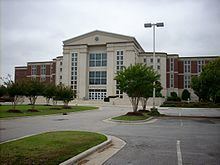Congressional districts 2nd, 4th Website www.harnett.org Founded 1855 | Area 1,557 km² Population 124,987 (2013) Points of interest Aloha Safari Zoo | |
 | ||
Colleges and Universities Campbell University, Lundy–Fetterman School of Business, Heritage Bible College, Campbell University Divinity S Destinations | ||
Harnett County is a county located in the U.S. state of North Carolina. As of the 2010 census, the population was 114,678. Its county seat is Lillington, and its largest city is Dunn.
Contents
- Map of Harnett County NC USA
- History
- Geography
- Adjacent counties
- Demographics
- Law and government
- Education
- City
- Towns
- Census designated places
- References
Map of Harnett County, NC, USA
Harnett County comprises the Dunn, NC Micropolitan Statistical Area, which is a part of the greater Raleigh-Durham-Chapel Hill, NC Combined Statistical Area, which had a 2013 estimated population of 2,037,430.
History
Harnett County was formed in 1855 from land given by Cumberland County. It was named for American Revolutionary war soldier Cornelius Harnett, who was also a delegate to the Continental Congress. The first settlers came to the region in the mid-1720s, and were followed by Highland Scots immigrants. The Scots settled in the foothills, where land was more affordable, rather than in the rich alluvial soil area of the coastal plain. After the defeat by the British of Bonny Prince Charles at Culloden, Scots immigrants came up the Cape Fear River in ever increasing numbers and settled in western Harnett County. British immigrants had settled primarily along the banks of the Cape Fear River in the coastal area, generally from Erwin to Wilmington.
During the American Revolutionary War, many of the Scots were Loyalists. In their defeat in Scotland, they had been forced to take ironclad vows that prohibited taking up arms against the British. Some Rebels considered them traitors to the cause of Independence. Public executions of suspected spies occurred. One site near Lillington was the scene of a mass execution of "Scots Traitors."
Though Harnett County was not a site of warfare during the Civil War, one of the last battles took place near Averasboro which was once the third most populated town in North Carolina but is no longer in existence. During the Carolinas Campaign the Left Wing of General William Sherman's army under the command of Maj. General Henry W. Slocum defeated the army of General William Hardee in the Battle of Averasborough and proceeded eastward. A centennial celebration of the event was held in 1965 at the site of the battlefield.
Geography
According to the U.S. Census Bureau, the county has a total area of 601 square miles (1,560 km2), of which 595 square miles (1,540 km2) is land and 6.3 square miles (16 km2) (1.1%) is water.
Adjacent counties
Demographics
As of the census of 2000, there were 91,025 people, 33,800 households, and 24,099 families residing in the county. The population density was 153 people per square mile (59/km²). There were 38,605 housing units at an average density of 65 per square mile (25/km²). The racial makeup of the county was 71.13% White, 22.50% Black or African American, 0.87% Native American, 0.65% Asian, 0.07% Pacific Islander, 3.21% from other races, and 1.57% from two or more races. 5.86% of the population were Hispanic or Latino of any race.
There were 33,800 households out of which 36.00% had children under the age of 18 living with them, 53.20% were married couples living together, 13.50% had a female householder with no husband present, and 28.70% were non-families. 23.30% of all households were made up of individuals and 8.50% had someone living alone who was 65 years of age or older. The average household size was 2.61 and the average family size was 3.07.
In the county, the population was spread out with 27.00% under the age of 18, 10.60% from 18 to 24, 32.10% from 25 to 44, 19.90% from 45 to 64, and 10.40% who were 65 years of age or older. The median age was 32 years. For every 100 females there were 97.40 males. For every 100 females age 18 and over, there were 95.00 males.
The median income for a household in the county was $35,105, and the median income for a family was $41,176. Males had a median income of $30,265 versus $22,283 for females. The per capita income for the county was $16,775. About 11.30% of families and 14.90% of the population were below the poverty line, including 17.20% of those under age 18 and 19.40% of those age 65 or over.
Law and government
Harnett County is a member of the regional Mid-Carolina Council of Governments.
Education
Harnett County is home to Campbell University and to 27 other different schools: 4 primary schools, 13 elementary schools, 5 middle schools, 4 high schools, and 1 alternative school.
